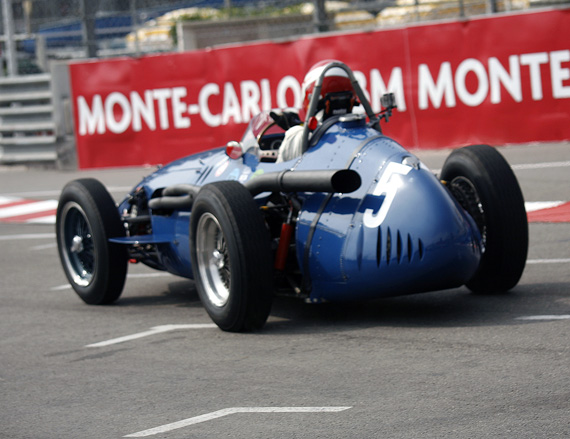
Frank Stippler slides the ex-Temple Buell 250F Maserati (2533) through the kink before the swimming pool at Monaco.
Story and photos by Graham Gauld
250F Complications
Some weeks have passed since the Monaco Historic event but as it always triggers off various memories. Please forgive me for commenting on another couple of cars that took part this year. One was the Maserati 250F Picolo owned by Jos Koster and raced by German driver Frank Stippler.
Stippler is no slouch and has been one of Audi’s test drivers for the past few seasons, but was not so familiar with cars of the 1950s era. However, as is often the case with professional racing drivers, such talent can be adjusted to any type of car. Certainly on the confines of Monaco Stippler was not only fast but willing to let the Maserati slip and slide the way the drivers used to drive them. He had a good race and finished second to Tony Wood in the Tec Mec Maserati.
However what was interesting to me was that in 1958, I saw this Maserati for the first time at the Modena Autodrome. By that time Maserati were in real financial trouble. They had ditched the factory racing team at the end of the previous season and so when American enthusiast Temple Buell arrived in Modena in 1958 looking for a couple of cars to race Maserati were more than willing to sell them to him.
When I originally drafted this piece I decided to check out my photos with the man I consider the world expert on 250F Maseratis, Barrie Hobkirk in Canada. Believe it or not, I found that had confused the two Buell cars even back in 1958, part reason being that apart from Denis Jenkinson,few of us ever looked for chassis numbers. Hobkirk has made an exhaustive study of these cars and supplied a lot of information to the late David McKinney who wrote the so-far definitive book on the 250F. Thank goodness I did, because he was able to sort out which car was which and not end up in the do-do.
The Stippler car at Monaco had originally started out as chassis 2532, the first Piccolo, and had run in the French Grand Prix in July of ’58 with no less than Juan Manuel Fangio at the wheel. It was then left at the factory until Temple came along when it was renumbered as 2533 and prepared for Carroll Shelby to run in the Portuguese Grand Prix – his first Grand Prix. Now pay attention.
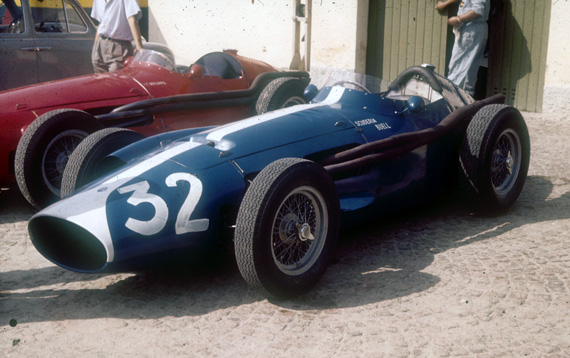
The same 250F (2533) - with its race number changed from 34 to 32 and driven by Masten Gregory to finish 4th at the Italian Grand Prix at Monza in 1958.
A few days before the 1958 Italian Grand Prix at Monza Buell’s second car (2534) was delivered to the Modena Autodrome to be prepared for Masten Gregory to race. Buell arrived at Monza with both of his cars. However, during practice the new car (2534) was handling badly and so the “2” from its race number, 32, was stripped off and the car was withdrawn from the race. The team then borrowed another 250F (2522) from Scuderia Centro Sud so that Shelby could get a drive.
2534 was taken back to the factory with only the number 3 on it as the “2” was switched on to chassis 2533 – the car Shelby was supposed to drive. Therefore Gregory drove in the Italian Grand Prix with chassis 2533. We assume that you have followed this with complete understanding.
Later when Buell was finished with it, 2533 was returned to the factory and sold to Mimo Dei of Scuderia Centro Sud before coming to the States with Joe Lubin. Eventually it came back to Europe and its present owner Jo Koster and is the Stippler car seen herein.
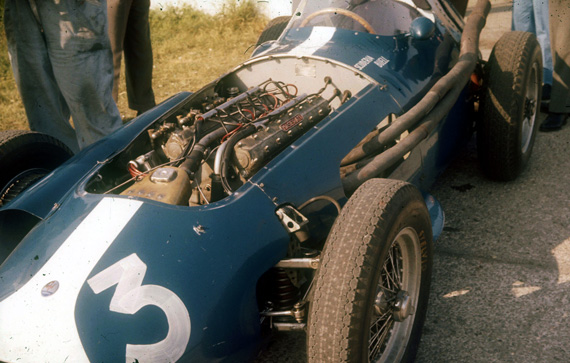
Temple Buell’s new car (2534) photographed at Modena a few days after the Italian Grand Prix of 1958 showing where the number 2 was stripped off. Traces of number 2 can be faintly seen next to the 3.
Now to the photographs (one of which appears on page 80 in Modena Racing Memories). I had not realized that the photos I took at Modena Autodrome of the newest of the Buell Cars (2534) were taken after the Italian Grand Prix and not before as they clearly show the car with only the number 3 left on it after the 2 had been removed at Monza. In the caption in my book, I stated that the photo was taken before the Italian Grand Prix. For over fifty years I have misrepresented the two cars in picture captions for which I apologise. Now the pictures have the correct captions for all you rivet-counters. This is all thanks to Barrie Hobkirk and his meticulous research.
The Dobbs Riley
Another car at Monaco caught my eye looked like the runt of the litter, but was in fact a car with an interesting history, the Dobbs-Riley. British motor racing before WW II was littered with Specials because most races run at the Donington and Brooklands tracks used their own system of race classes and did not run on the International Formula that covered the big Grand Prix races. Another reason was that a few people built special racing engines or grafted airplane engines into chassis to run at Brooklands.
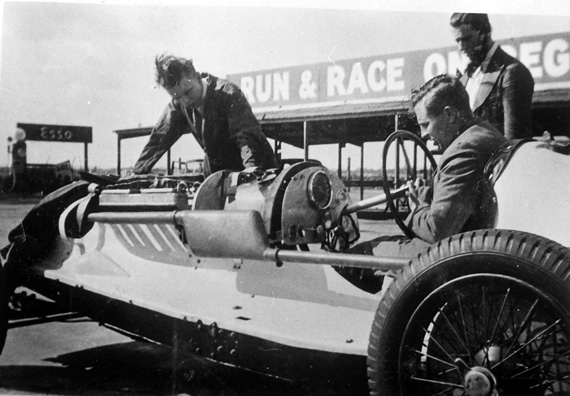
The original Dobbs-Riley in the paddock at Brooklands around 1936; note the unique Brooklands silencer.
However, the six-cylinder Riley engine proved to be ideal for development and it became as popular in England back then as the Coventry-Climax fire pump engine was to become in the ‘60s. It was the Riley engine that was the basis of Britain’s most successful pre-war racing car, the ERA and in supercharged form it won a bag full of races and is still an iconic marque.
Others got into the act including Hector Dobbs, who owned Hedge End Motors in the south of England. He built two specials, one with a 1500cc engine and the other with a 2 liter developed by the Riley company. His car was based on a Riley MPH road car Dobbs bought new from the factory. The Dobbs 1500cc car was very successful and was sold to Arthur Dobson who ran it in the support race to the French Grand Prix.
The Dobbs 2 liter car ran on methanol with 6 Amal carbs was raced in the late 1930s by British bandleader Bill Cotton, and after the war it came into the hands of Roy Salvadori. The Dobbs-Riley had an offset single-seater bodywork which weighed only 12.5 kilos (27.5 lbs) and the overall weight of the car was only 550 kilos (1212 lbs) so it proved to be very quick even though, unlike the ERAs, it was not supercharged.
During the intervening years the car changed hands, and had an Alta body modified to replicate the pre-war bodywork. It was sold at an auction around five or six years ago. Its present day owner and driver is Frenchman Thierry Chanoine who was out in it at Monaco. He finished 8th in the race just behind Tony Smith’s Alfa Monza and so the car is still going strong some 80 years after it was built.
The Silver Hawk at Draguignan
Talking about pre-war race cars, it is surprising how many of the British cars are owned by Frenchmen. One of them, Didier Vives, lives not far away from me here in the South of France, and at one time he owned a number of race cars including a Stanguellini. However the car that interested me and which he demonstrated at an event in his native town of Draguignan about ten years ago was the Silver Hawk, another of those specials mentioned earlier.
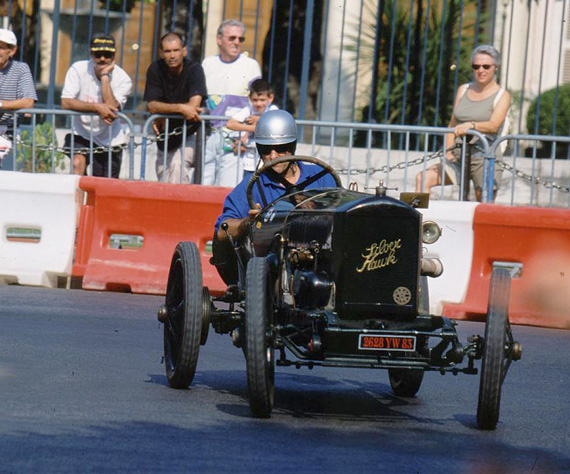
Didier Vives hurls the Silver Hawk round a roundabout in the middle of Draguignan during a demonstration event ten years ago.
The Silver Hawk was one of twelve such cars developed and built by Noel Macklin (whose son Lance Macklin became a well-known race driver for HWM, but sadly is best known for the one whose Austin-Healey was involved in the 1955 Le Mans disaster). Noel Macklin came from a wealthy family and ran a GP Fiat at Brooklands before 1914. He joined forces with Eric Orr-Ewing to build the Eric-Campbell car, one of which ran in the 1919 Targa Florio, no less.
Next, Macklin decided on another project, the Silver Hawk. This race car used the Coventry-Simplex engine, but one was built with a Sage engine and the cars were very successful in the hands of private owners. Indeed the first woman to try and set British speed records at Brooklands, Violet Cordery, did so with a Silver Hawk. (Note that the cars were sometimes entered as Eric-Campbells and other times as Silver Hawks).
Veteran French driver Rene Thomas ran one of five Silver Hawks entered for the Voiturette race at Le Mans in 1920 with Noel Macklin as another member of the team. Thomas named his car “Le Crocodile” and finished 7th in the race won by Friderich’s Brescia Bugatti, and another Silver Hawk driven by the British driver Gedge was sixth. However financial times were hard for Macklin and around ten months later, in 1921, the Silver Hawk Motor Company was wound up and we were to wait until 1925 when Noel Macklin came back on the scene and developed his most successful car, the Invicta.
As for Didier Vives, I have not seen him for ages and presume he may have sold his Silver Hawk but when he owned it he drove it with verve and usually on the limit most of the time.
Jackie on Tour
Been recovering from the Ecurie Ecosse Tour that I organize in Scotland each year. This is an invitation-only event for twenty friends of Ecurie Ecosse Patron Hugh McCaig, with interesting cars and interesting people.
This year was something really special, for back in July last year, Sir Jackie Stewart had been ribbing Hugh and me about coming on the Tour. But Sir Jackie finally found time in his heavy schedule to fly into Inverness in the north of Scotland with his “co-driver” His Royal Highness the Duke of Kent, where Jaguar Cars had delivered a brand new Jaguar F type Coupe for them to run on the event.
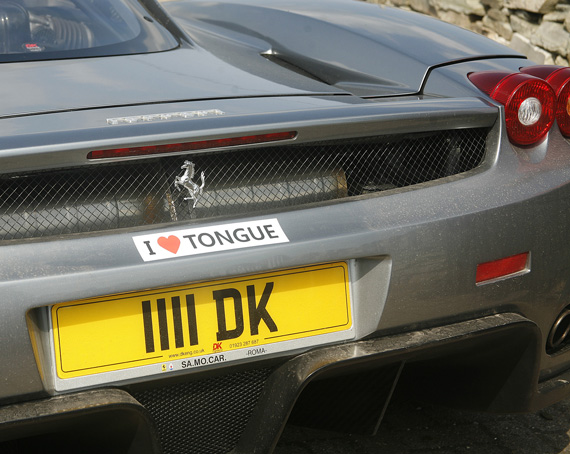
The most popular souvenir from the Ecurie Ecosse Tour much favoured by the younger competitors such as James Cottingham who put one on his father’s Ferrari Enzo.
There was as usual a rare mixture of cars including James Cottingham – his father David is boss of DK Engineering who refurbish and rebuild some of the most important Ferraris of the past – who had borrowed dad’s Ferrari Enzo. This led to an amusing incident as one of the lunch stops was at the Scottish Highland village of Tongue. Needless to say one of the local shops had the sticker “I love Tongue” and our drivers bought every one of them as souvenirs.

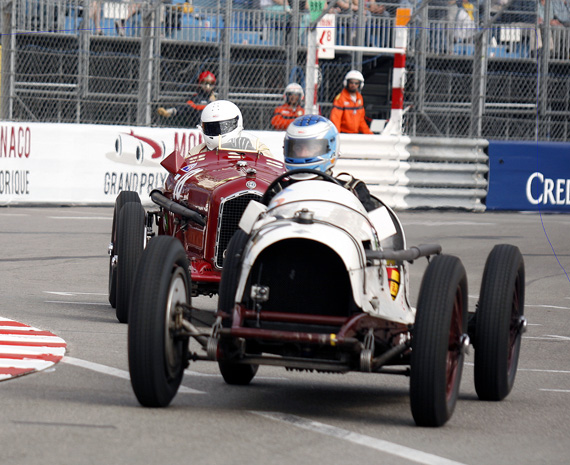
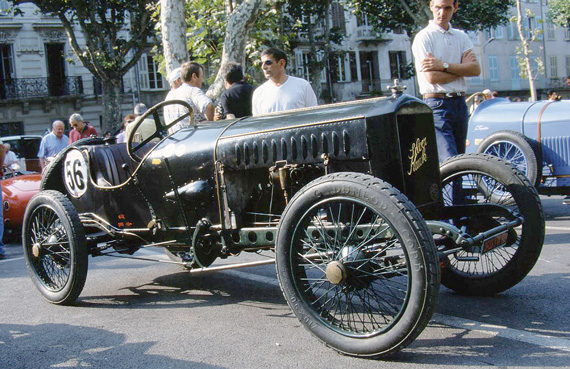
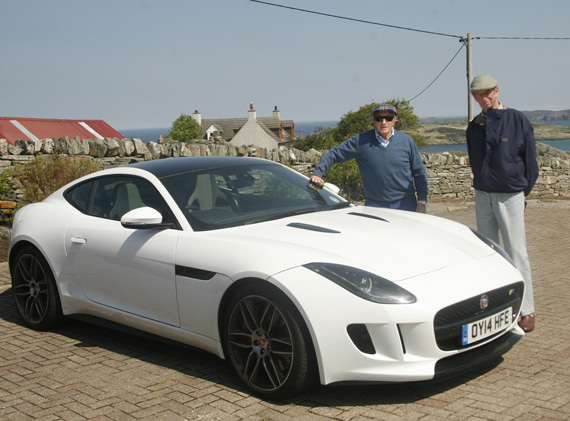
As always, Graham never fails to entertain. I loved this article. John
Yes, I agree. A very entertaining, and informative, article.